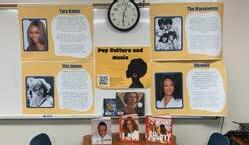








I like this quote because we are so different. Every teacher is different from each other. To me this is a good example of what authentic teaching is all about.
Even though we are given manuscripts to use as content materials for instruction we still have our personalities to content with. Authentic teaching is the application of your own real or genuine character traits and mannerisms when you connect what needs to be taught, with your personality traits. I love to tell jokes, sing, and make funny faces when I like what I am talking about. Manuscripts can not give me those special little features I add to my lessons.
do what comes naturally, just teach. So why would you stifle your personality when you are in the classroom?


I am going out on a limb here, but when I look at the scripts in my Amplify and Eureka packets, I safely File 13 them and then do what I do best, I teach! I use my own words and my own strategies. My own hand gestures, my own facial features, my unique noises that make my students laugh and connect with me, and other methods that I have in my plethora of knowledge that I have accumulated throughout the decades that I have been in public and higher ed. classrooms. Don’t try to departmentalize your teaching methods, just
When students look at the teacher, they see a genuine reflection of that teacher’s personal identity. Authenticity here finds expression in consistency between values and actions. Being true in this sense means not being defined by others but using self-knowledge to establish one’s own identity, regardless of how well or poorly it fits with the expectations of others. Authenticity extends beyond the individual. It is other directed as well. In the case of teachers, it is caring about students and wanting them to flourish.
“Children learn from who you are than what you teach”, author unknown. It’s hardly an exaggeration to say now. Teachers be true, be honest, and be real. That’s all you can be. Let me remind you no one can replace you. You are Unique and One of a Kind. I’ll be so honored to be your Valentine.
Send me a Valentine note to cokercathy70@yahoo. com I’d love to hear from you.

“To thine own self be true,” is spoken by Polonius, a counselor to the King, Claudius, in Act 1 Scene 3 of Shakespeare’s play, Hamlet.
Designers: Rivette Pena
Stephane Bowker
Contributing Photographers and Stock Libraries: Adobe Stock
Unsplash
Andy Dominguez
Advertisements: Dr. Cathy Coker
Marketing: Alicia Grace
Thank you to Stephane Bowker at Working
for providing tailored training for the layout of Teachers Making a Difference.















 by Elaine Clanton Harpine, Ph. D
by Elaine Clanton Harpine, Ph. D
There is no one central area of the brain that controls reading. Instead, there is a “network of connections or synaptic pathways.” When these pathways are developed, reading a word can take less than half a second, but reading does not happen automatically, it must be taught. Students must be taught how to make the connections between letters and sounds. Vowel clustering does not use rules or memorization. Vowel clustering teaches students to break words down and identify the sounds. The method that we use to teach reading is what keeps some children from learning how to read. The problem is not the teachers or the students. Reading failure is caused by how we teach reading. Vowel clustering works with the brain to make it easier for children to learn to read. For more on research about how the brain learns to read, see my blog post on teaching vowel clustering: https://www.groupcentered.com/ reading-blog/archives/03-2019
and vowel sounds with their corresponding letter symbols. This emphasizes the oral letter-sound relationship. Remember, we are training the brain, building “pathways” in the brain.
Vowel clustering works with the brain and the way the brain processes phonemes or letter sounds. Vowel clustering uses visual, auditory, and hands-on teaching techniques. Vowel clustering teaches students to match consonant
Therefore, it is important to organize how we teach so students can organize how they learn. We want to work with the brain, not against it. The vowel clustering teaching approach presents a visual and oral picture that struggling students can immediately identify with. Visually, students match words by how they sound not by how they are spelled. This teaches students that words can be pronounced one way but spelled another. This visual-auditory learning technique allows students to both see and hear letter sounds (phonemes).
For more on how to use a vowel board to teach letter sounds, see an excerpt from my newest book, Why Can’t We Teach Children to Read: Oh, But Wait We Can. See: https://www. groupcentered.com/reading-blog/is-readingfailure-linked-to-violence-crime-and-mentalhealth

It is never too late to correct reading failure:




A 15-year-old student was brought to my reading clinic because the school had said, “she could never learn to read.” In middle school, she was given coloring book pages and shuffled off to the corner of the classroom. The school was using “balanced literacy” in the classroom, and the student had received one-on-one tutoring in systematic phonics from early elementary school to middle school, but the student was still failing. I taught the student to read in 3 ½ years using vowel clustering.


These are just two examples; I have many others. If you are interested in learning more about vowel clustering, contact me at clantonharpine@hotmail. com. I am always happy to help.

Also:
A very smart third grader was brought to my reading clinic. The student could not even read at the beginning kindergarten level. The student’s parents were college-educated and had even paid for private systematic phonics tutoring. Balanced literacy from the classroom, pullout small group phonics instruction during school, and even private one-on-one systematic phonics instruction failed to teach this student how to read. Again, I taught the student to read in one year with vowel clustering.


#RepresentationMatters. As an educator, I believe that it is important to celebrate all cultural backgrounds represented in our schools. This allows students to learn and embrace the students they share classes with and the communities in which they live. It also provides educators the opportunity to learn about the students and the families they serve. As a former teacher and current school administrator, I always make sure to cultivate experiences for my students to help bring awareness and celebrate Black culture. Below are my top 10 favorite activities to celebrate Black History Month in schools:


Hosted by the school librarian - students would use the knowledge acquired over the duration of Black History Month to illustrate on a bookmarker. They would then be voted on by the student body to determine a winner.

Using an empty classroom or room in the school, teachers created a museum encompassing multiple aspects of Black history. Each wall in the room focused on something different with QR codes for the students to scan with iPads. One wall was dedicated to the arts, another wall focused on history, and the other on pop culture. All content was age appropriate for the grade level.

On the morning announcements, students would read Black history facts. Students were then asked trivia questions at lunch for a prize to encourage them to listen to the morning announcements.
In the era of COVID-19, we were not permitted to have guests on campus, so we would set up Zoom meetings with our students and influential Black community members. Students were required to do research on the person, write the questions, and lead the interview while being supervised by a staff member.
Black community leaders would come in and meet with the student body. We had non-profit organizations, presidents of large businesses, and professors from the local university come in to speak with our students.
On the morning announcements, we would have students discuss their projects over Jazz music to the student body. At lunch, the Jazz music discussed during the morning announcements would be played while the students were eating.

Every Tuesday in February, students would stay after school to watch age appropriate films that highlight Black history. Some of the films included Black Panther, Selma, Hidden Figures, and Pride.

Advisory classes selected 1 HBCU (Historically Black Colleges and Universities) to research and create an informational poster. Posters were then displayed and voted on. The winning advisory received recognition and a prize.


The word ‘Black’ tends to have a negative connotation, so on #BlackIsBeautifulDay, students and staff were encouraged to wear the color Black or shades of brown to embrace the beauty of the word ‘Black’.
Teachers created informational posters for their students to engage in a gallery walk throughout the month. Students were then quizzed on the information during pep-rallies.


• 2 lb chicken thighs, sliced into chunks
• 1 cup soy sauce
• ½ cup brown sugar
Directions
1. Sear the chicken thighs evenly in a pan, then flip.
2. Add the soy sauce and brown sugar, stirring and bringing to a boil.
3. Stir until the sauce has reduced and evenly glazes the chicken.
4. Serve with rice, if desired!
Love yourself and your family with this easy delicious recipe.
Please submit any recipes you would like to share by sending them to articles4magazine@gmail.com subject: recipes visit www.testprepcertification.com for submission requirements
















 Dr. Danielle Lowe
Dr. Danielle Lowe
As a leader in the community and taxpayer, I am hopeful that you will share my passion to help children in our community. There is a serious injustice occurring in schools, not only in Orange County, but across the United States. Our children are being assaulted with political and corporate rapacity. Teachers and parents substantiate, that children in need of special education services, are being denied! Students with diagnoses from doctors, as well as parental advocacy are being deprived the right to a fair and equal education. This is a moral and legal injustice. As a veteran teacher, I am often disgusted by the changes I have observed in the educational system over the past few years. We possess decades of research demonstrating the most effective developmentally appropriate practices. Yet, this knowledge is being replaced by test preparation and financial budget boundaries.
Despite this research-based insight, schools across the county have replaced constructivist learning with standardized tests, technology, and “data-driven instruction.” Sand and water tables have been replaced with pencils and digital passwords. Dramatic play, recess, and creativity, are substituted with inappropriate environmental and cognitive expectations. Although this is an ethical perspective, it is not illegal to impose educational procedures. However, it is clear that experts in the field of education are NOT making decisions regarding the education and teaching of children.
It is our responsibility as a society to care for our children and foster their learning experiences, in an effort to create a sound educational foundation. Individuals learn best through hands on experience and “play.” The brain is most permeable up to the age of 4. Socialization and learning through problem-solving creates opportunities to establish prior knowledge so that students can scaffold new information in the future.
Recently, I was astonished to learn that despite the unquestionable evidence proving that many student were learning disabled, they were still deemed ineligible for Special Education services. Regardless of interventions and years of documentation by parents, teachers, and physicians, the “committee” deemed the child ineligible. As an educator, I am irate and continue to work with the families in an effort to meet the child’s needs. However, after experiencing this same pattern repeatedly, I do NOT understand how this could happen in our current education system.

Initially I began pulling out my educational law and learning disability resources desperate to find a resolution to this insanity. I realized that the best way to express my own frustration and hopefully develop a solution is with a team of other “Wholechild” supporters. I reached out to educational staff members and parents throughout cities, counties, and even countries. After posting my quandary on a private educational forum for teachers, I was amazed and appalled when within minutes, dozens of teachers shared their similar experiences across the country. This was not an isolated situation, but hundreds…, no thousands of children, were deemed ineligible for special education services despite mountains of documentation stating otherwise. How could this be happening across the country and politicians are not fighting for justice?? Why are parents, teachers, and advocates not banning together to make change for our children?
behaviors arise because the individual becomes “lost” and is trying to escape. The educational field should not possess corporate procedures and financial gain mentality. These are children and we are constructing their future internal dialogue. We need to support America’s children and create opportunities for development and individuality. It is our responsibility to establish opportunities for children to believe in themselves and their future!



Unfortunately, I learned that money, greed, and political gain are playing a role in this discrimination. According to one source, districts can be fined if they have too many special education students! Furthermore, when children are classified, it requires different financial obligations and budgets. Let’s not forget about the “keeping up with appearances” factor. Are leaders still seriously worried about the reputation and appearances over a child wellbeing? Students that are deemed ineligible after years of difficulty, become old enough to realize they struggle in comparison with other students. Unfortunately, the result becomes damaged selfesteem and increased behavior issues. These
I am not foolish and realize those that advocate can be subjected to retribution and sabotage. However, I cannot understand why more people are not standing up to this injustice occurring in our country. This issue is not about money or debate, it is about children! They are OUR future. We need to stand up for the voiceless and help others to find their voice as well. This is a conversation that needs to be addressed. I am happy to share my research with anyone interested.
Please stand up for a fair and equal education for all students. I look forward to your response, as well as hopefully working with you to create a better future for our children.
There are six different colors of candy hearts in the box: green, pink, yellow, blue, purple and orange. Assuming that there are equal amounts of each color, answer the following questions.
1. What is the likelihood of randomly choosing a green?____________________________
2. What is the likelihood of randomly choosing a color that is not yellow?__________
3. What is the probability of choosing a yellow heart then a blue heart?____________
4. What is the probability of choosing a pink heart, then not choosing a green heart?__________________________
5. Based on this information, how many pink hearts would you find in a box of 36 hearts?_______________
Choose 10 hearts out of the box randomly and record the data in the table below.
Based on the data you collected in the table answer the questions below.
6. What is the likelihood of randomly choosing a green? __________________________
7. What is the likelihood of randomly choosing a color that is not yellow?_________
8. What is the probability of choosing a yellow heart, replacing it, then choosing blue heart?___________
9. What is the probability of choosing a pink heart, replacing it, then not choosing a green heart?______________


Based on the data you collected in the table 1 answer the questions s below.
10. What is the probability of choosing a purple heart, not replacing it then choosing another purple?__________________________
11. What is the probability of choosing a blue, not replacing it and not choosing a blue?
12. Based on table 1, how many hearts would be green in a box of 250 hearts?
Use e the information from the front of the page to answer the following questions.
13. Was there a greater likelihood of randomly choosing a pink heart with the theoretical probability or the experimental probability?______________________
14. Which color had the biggest change in probability?____________________________
15. Based on the data in the table, if you added 5 yellow hearts how would the likelihood of choosing a green heart change?
Table 2 Use the rest of the hearts in the box to complete the table below.
Use the information from both tables to answer the following questions.
16. Was there a greater likelihood of randomly choosing a purple heart in table one or table two?______________________
17. What is the probability of choosing a blue from table 1 then choosing a green from table 2?____________________________
18. What is the probability of choosing a pink from table 1 then not choosing a yellow from table 2?
19. If you combined all the hearts together, how would it effect the probability of choosing an orange? __________________________________
Content Objective:
I will say, spell and write words.
Language Objective:
I will say the spelling word with my device. I will spell the word along with the teacher. I will write the spelling word in the shaving cream.
Lesson Time: 30 minutes
Materials:
• Shaving cream

• Trays (optional)
• list of words with native language support
• paper towels or baby wipes for clean up

will then model say and write a word on the board with the shaving cream. Students will then say, write and then say the word on the tray with the Shaving cream. Teacher will then model how to “clear the board” to be able to say, write and say the next word on the list.
Introduction/Review:
Teacher will display high frequency Spelling List
1. Teacher will introduce the activity by asking a focus question about one of the spelling words. For example “What are the letters in ‘for’?” teacher will then say “please say, spell, say the spelling words with me.
Activity:
Teacher will say, ‘Today your job is to spell and write words on the tray with shaving cream.” teacher will display the letter tracing sheet. Teacher

TEKS:
3.11 Edit Text, 4.15 Edit Text using correct grammar and spelling, 5.11 Edit Text
Instructional Targets:
1) Read common sight words (e.g,. high-frequency items from Dolch/Fry list and commonly occurring words in the environment). Use letter-sound knowledge and patterns to decode words (e.g., vowel digraphs, blends, spelling patterns, word families, etc.)
2) Correctly spell words with common spelling patterns.

Check for understanding/Exemplar:
Student will either say or use AT to say and spell the words, thenn they will write, or trace their words.




A teacher’s Bill of Rights appears to be needed at this most important time. The many experiences of this author will help guide the key issues and outcomes to be highlighted in this article. These experiences include secondary school teacher and counselor, teacher union leader, a community college instruction leader, adjunct university faculty member and as a community college president and a state, national and international speaker on these topics.
The ‘High Stakes Testing (HST)’ and ‘Merit Pay’ movement over the past decade has brought to the surface issues that should not have developed (Andrews, 2021). Several of them are outlined here:
• Evaluating teachers by the ‘scores’ their students receive on these state and national exams
• Deciding on retention or dismissal of teachers based on these tests and not on their actual classroom teaching expertise
• Rewarding teachers with a ‘merit pay’ system that had failed everywhere it was implemented over the previous 50+ years

• Merit pay being granted to those teachers who may have been able to ‘recruit’ top students to their classes for the purpose of improving the test scores for those teachers’ students
Watching these things develop over the last decade has brought to mind so many of the things that teachers should expect but were pushed aside. With this in mind the following expectations should become guidelines toward a Teacher Bill of Rights for teachers everywhere:
Teacher expectations of ‘evaluators: Competent evaluators should be expected and used in all evaluations of teachers.
• Evaluators should have been excellent classroom teachers themselves.
• Evaluators need to be able to accept a wide range of teaching processes they observe.
• Evaluators and teachers should both have a clear understanding of the evaluation processes to be utilized.
• The instruments to be used will have been reviewed and understood by teachers so they will know the expectations of evaluation and can offer improvement suggestions.
• Consistency in evaluation should be expected teachers and practiced by evaluators.
• Fairness needs to be expected and will allow for teachers to express disagreement where there are questionable evaluation comments or observations recorded.
• Disagreements should be expressed both orally and in writing if necessary.
• Feedback from the evaluator should be made in a reasonably short time to help relieve the anxiety of those evaluated.
• Feedback should be both verbal and written and allow for discourse from both evaluator and teacher
• Positive ‘recognition’ should be expressed both orally and in writing for excellent teachers.
If there are areas suggested for ‘remedial’ work to be done there should be a time frame announced so the teacher has an expectation of what to work on, receive assistance, and have follow-up evaluations to chart progress.
A teacher bill of rights as outlined here should be looked at as ‘guidelines’ in developing or in improving a professional evaluation system. Such a well designed system with input from both teachers and administrators can build trust and support between teachers and administrative evaluators, and help make it a positive experience for both teacher and evaluator.
The whole process of evaluation after tenure or long-term hiring has been awarded was well stated by the National Commission of Higher Education Issues (1982):
• It should assure that the tenured faculty member continues to maintain the appropriate level of competence as when they received tenure.
• It is the responsibility of both the evaluator and teachers to follow up to see that unsatisfactory performances are re-mediated.
• Incompetent faculty members should not be protected at the expense of the students.
Evaluation: Formative or Summative
Over the years professional researchers have tended to classify teacher evaluation as either formative or summative. The following describes what is meant by both:
Formative teacher evaluation
An evaluation conducted for the purpose of improving the teacher through identifying that teacher’s strengths and weaknesses.
Summative teacher evaluation
An evaluation conducted primarily for the purpose of making personnel decisions about the teacher
e.g., special recognition, reassignment, promotion, dismissal, tenure (Teacher Evaluation Glossary, 2003).
Licata and Andrews (1990) took issue about whether evaluation has to be divided as either being formative or summative. They saw evaluation as a continuum providing formative support for teachers even during a process of remediation of teaching techniques that were identified as insufficient.
They suggested that there will sometimes be negative outcomes in most any evaluation system whether they are considered formative or summative. In their discussion on the continuum they pointed out that those who seem to have to have a dual system are not working in the same reality as those who are in the trenches of evaluation.
Most teachers respect their evaluators who continue to work with them to improve their delivery of competent instruction to their students. When asked to state some ways that their teacher evaluation could be improved the following type of responses were received:
• Utilize the results in a meaningful way to let faculty know when they are doing an excellent job and when they need help
• More feedback and awards from the system
• Reward the effective faculty members, not the slouches; there is not enough distinction now
School districts around the world have a big job ahead as they come out of the two plus years of the pandemic. Many teachers have become worn down and need a boost from the governing boards and school administrators to help them bounce back.
Working toward a ‘teacher bill of rights’ will help build positive expectations on how their teaching lives can be supported now and into the upcoming years.
 by Dr. Cathy Coker
by Dr. Cathy Coker

Teachers, we really need to be informed as to why we take time in class to celebrate certain days in the school year. Valentine’s Day is one of them. Valentine’s Day occurs every February 14 in the United States as well as all around the world, candy, flowers, and gifts are exchanged between loved ones, all in the name of St. Valentine. But who is this mysterious saint and where did these traditions come from?
One legend contends that Valentine was a priest who served during the third century in Rome. When Emperor Claudius II decided that single men made better soldiers than those with wives and families, he outlawed marriage for young men. Valentine, realizing the injustice of the decree, defied Claudius and continued to perform marriages for young lovers in secret. When Valentine’s actions were discovered, Claudius ordered that he be put to death.
Some historians insist that it was Saint Valentine of Terni, a bishop, who was the true namesake of the holiday. He, too, was beheaded by Claudius II outside Rome. I don’t think I like Emperor Claudius right now. Though it is true to an extent the men would be distracted but they should have never been forbidden to marry if they wanted to.

Other stories suggest that Valentine may have been killed for attempting to help Christians escape harsh Roman prisons, where they were often beaten and tortured.

importantly a romantic figure. St. Valentine has become a popular saint around the world today.
Teach your students the history of why we celebrate Valentine’s Day and why it’s okay to say, “I love You,” without blushing. Thanks to St. Valentine this is one day that we can express our love for one another without judgement.


According to one legend, an imprisoned Valentine did send the first “valentine” greeting. While in prison he fell in love with a young girl, possibly his jailor’s daughter who visited him during his confinement.
Before his death, it is alleged that he wrote her a letter signed “From your Valentine,” an expression that is still in use today. Although the truth behind the Valentine legends is murky, The stories all emphasize his appeal as a sympathetic, heroic, and most




Name:____________________ Date:_______________

Paul the porcupine had so many special gifts within himself. Mother Earth had taught Rabbit that Paul was an animal that symbolizes strength, defense, curiosity, innocence, and helpfulness. She also told Rabbit not to be afraid of Paul’s quills because those quills are hollow and can be easily filled with air when faced with adversity and Rabbit was not that kind of a critter he was a true friend. After thinking about it he has never seen Paul blow up his quills before. Paul wanted others to look at him as their Knight. When his gills are inflated he can use them to save people or the animals if they are in danger.
1. What are some adjectives that the author uses to describe Paul the Porcupine?

2. Why does Timid Rabbit believe what Mother Earth says about Paul the Porcupine?
3. Can you describe Paul the Porcupine with at least 3 other words?
 By Dr. Cathy Coker
By Dr. Cathy Coker


 By Dr. Cathy Coker
By Dr. Cathy Coker

As a math teacher, who had young children at home, I tried to stay abreast of popular shows,movies, music etc. Anything I could use to relate to my students. It helped that I was a kid at heart. I loved the modern pop music. My kids like all other kids jumped on to every fad.


passed, some of those became irrellevant to my current students. So I stuck with timeless themes, Iconic Movies-Lion King, Frozen, Cinderella, Super Heroes.
Those were well received and didn’t have to be updated as much. The kids appreciated the themes. Oh and I was as cheesy as humanly possible. Cringy even. I put in songs that were corny and made the kids groan but would also worm their way into their little brains. I would smile when I would hear them humming these songs.
Firstly, it helped me get closer to my kids. We spent many hours watching tv, playing games, listening to each others music. Those are moments I will always cherish.
It helped me to incorporate things into my lessons that were relevant to the students. I could create activities with themes that would pique their interest. At the highlight of my themed activities, I would center my powerpoint review games around popular television shows like Glee, Dancing with the Stars, Real Houswives ...My questions would have names of famous pop artists, rap artists, country artists or reality stars. But as the years
Take a worksheet that you are already going to use. Rewrite the problem using names from the top 10 rap artists of the year, or whatever category. There are top “whatever” list for anything you can think of. I’ve looked up clean silly names, top 10 superheroes, top 10 country artists, pop artists, rap artists, movie actors etc
Example:
Original question. Ms. Davis earns $25 an hour tutoring. She owes Mr. Smitth $200. How many hours must she tutor in order to make at least as much to pay off Mr. Smith?
New question:
Opt A : Miss Informed earns $25 an hour tutoring. She owes Mr Rhee $200. How many hours must she tutor in order to make at least as much to pay off Mr Rhee.?

Opt B : Wonder Woman earns $25 an hour tutoring new super heroes. She owes Iron Man $200. How many hours must she tutor in order to make at least as much to pay off Iron Man.?


The possiblitties are endless. Get as silly as you like the kids will giggle and tell you how cheesy it is but it wil get them reading and talking which is crucial to engagement.
This has been a very hot activity for years now. It may seem overwhelming. But I found easy ways to turn regular worksheets into simple yet engaging activities.
For instance, take a a 10 to 12 question worksheet. If it is already mulitiple choice then you are golden. If not you can create your own multiple choice answers. If the answers are exact, then that will work to.
Separate the worksheet into 3 groups/tiers/ rooms/tasks.

Example
(10 questions)
Group 1 has 4 questions
Group 2 has 3 questions
Group 3 has 3 questions
(12 questions)
Group 1 has 4 questions
Group 2 has 4 questions
Group 3 has 4 questions
If the answers for Group 1 are 1. A, 2. B, 3. C and 4. D, then your code to exit that level is ABCD. You can change the letters on the answer choices to make a word if you like, MATH, LOVE, etc.
If you use numbers, the code could be their sum. I like that the best. Answers 1. 5, 2. 1.4, 3. 8, 4, 10 Code 24.4
Now all you have to do is figure out how you want them to test their code. I use google forms. You can use power point, lock boxes, checking with the teacher, opening an enveloope, etc. Get creative.
Your students will thank you. (Unless their middle schoolers then just know that they didn’t hate it. LOL) You will enjoy it alot more. You can always write to me with any questions rivpena121@gmail. com with any questions or comments.
Example of a google form on page 34
Visit my store on TPT A Math Mindset
7.
4. Mark only one oval.
1 Elias bakes cookies 7 5 dozen cookies in 1 5 hours Which graph best represents the relationship between x the number of hours and y the number of dozens of cookies?



8.
5. Mark only one oval.
2 Cindy was making bracelets She made 8 bracelets in one hour Which equation best represents y, the total number of bracelets that Cindy can make in x, number of hours?
6. Mark only one oval.
3 Which answer choice represents a plant growing 12 inches in 3 weeks?
B y=12x+3 U A plant grows 24 inches in 5 weeks

L Y
4 Antonio walked at a constant rate of 0 05 kilometers per minute Which table represents y the number of kilometers Antonio walked in x, number of minutes? Input


Mark only one oval.
Yay Bud has sent out the invitations but he is convinced no one wi come unless there are refreshments
To see this and many other fun math activities visit my teacher store.







Are you wishing for learning and growth opportunities? We have something great for you.
Come join us for a free workshop that trains you on The Science of Teaching Reading.

Get in on the groundfloor of a lucrative endeveor. We will train you to become a Trainer of Trainers. You can go forth and conduct your own seminars.
Whether you are interested in the Science of Teaching Reading or starting your own side business. Come to this free workshop. Earn six hours of continuing education hours. You will leave with some very engaging activities and methods. You will learn how to integrate reading into other content areas. Join us. All that is required is you filling out the interest form.





